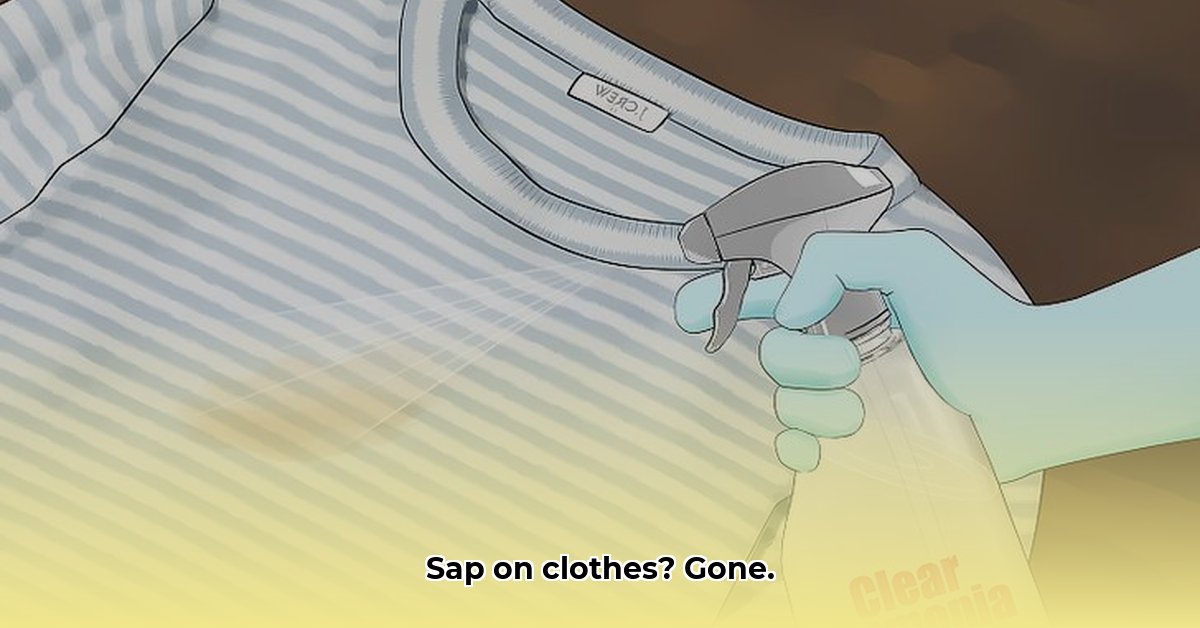Banishing Sticky Tree Sap: A Comprehensive Guide
Tree sap. That sticky, stubborn residue from trees can be a real nuisance, clinging to clothes and refusing to let go. Whether you brushed against a pine tree or enjoyed a picnic under a maple, sap stains can feel like a laundry nightmare. But fear not! This guide offers effective methods for removing both fresh and dried sap, turning that sticky situation into a clean slate.
Understanding the Enemy: Why Remove Tree Sap Quickly?
Tree sap isn’t just sticky; it can permanently damage clothing fibers. The longer it sits, the stronger it adheres, attracting dirt and dust and potentially discoloring the fabric. Quick action is key to preventing long-term damage and preserving your clothes.
Fresh Sap Removal: Act Fast for Easy Cleaning
Fresh sap, while sticky, hasn’t had time to set deeply. This makes it easier to remove with readily available household items.
- Freezing: Place the garment in a plastic bag and freeze for 1-2 hours. The frozen sap becomes brittle, allowing you to gently scrape it off with a dull knife or credit card. This is particularly effective for thick sap.
- Rubbing Alcohol (Isopropyl Alcohol): Dab rubbing alcohol onto the stain with a cotton ball, blotting gently. The alcohol dissolves the sap, making it easy to lift. Always test on an inconspicuous area first. Hand sanitizer can also work in a pinch due to its alcohol content.
- Dish Soap: Apply a few drops of dish soap directly to the stain and gently rub it in. Let it sit for 15-20 minutes before rinsing. Dish soap’s grease-cutting properties also help break down sap.
- Sunscreen: While it sounds unusual, the oils in sunscreen can help dislodge fresh sap. Rub a small amount into the stain, let it sit for a few minutes, and then launder as usual. This method’s effectiveness may vary depending on the sunscreen and sap type. Research suggests the oils and emulsifiers in sunscreen work together to lift the sap, though further study is needed.
- Vinegar: A 50/50 solution of white vinegar and water can be effective. Soak the stain for 30 minutes, gently rub, and rinse. Vinegar’s acidity helps break down the sap. While some report success with apple cider vinegar, its efficacy is less understood.
Dried Sap Removal: Tackling Stubborn Stains
Dried sap requires a bit more effort, but these methods can often restore your clothes.
- Freezing and Scraping: As with fresh sap, freezing hardens the dried resin, making it easier to scrape away. After freezing, use a dull knife, spoon, or credit card to carefully remove the hardened sap.
- Rubbing Alcohol or Hand Sanitizer: Apply rubbing alcohol or hand sanitizer to the remaining stain after scraping, blotting gently until the stain fades.
- Vinegar and Ice: Combine the power of freezing and vinegar. Place ice on the stain to freeze the sap, then scrape. Afterward, apply white vinegar, let it sit, and rinse. The acetic acid in vinegar helps break down the sap.
The Laundry Detergent Method: A Versatile Approach
Laundry detergent, particularly those with enzymes, can effectively tackle both fresh and dried sap.
- Gentle Removal: Carefully remove excess sap using a soft cloth, avoiding harsh rubbing.
- Apply Detergent: Apply liquid laundry detergent directly to the stain, generously coating the area.
- Soak: Allow the detergent to sit for at least 30 minutes, or longer for stubborn stains.
- Rinse and Wash: Rinse thoroughly and launder the garment according to its care instructions.
Fabric-Specific Considerations
- Delicates (Silk, Lace, etc.): Opt for the gentlest methods like freezing or dish soap, or consult a professional dry cleaner.
- Sturdy Fabrics (Cotton, Denim, etc.): These can typically handle more robust cleaning methods.
- Suede and Leather: These require specialized cleaning; consult a professional.
Troubleshooting
- Stubborn Stains: Repeat the chosen method or try a different approach. Consider a commercial citrus-based cleaner (like Goo Gone) or a baking soda paste.
- Discoloration: Carefully dab the area with diluted hydrogen peroxide. Always test in an inconspicuous area first.
Preventing Sap Stains
- Awareness: Be mindful of your surroundings, especially when near trees.
- Protective Clothing: Wear long sleeves and pants in wooded areas.
- Barrier Creams: Applying sunscreen or other barrier creams to exposed skin can help prevent sap from sticking.
Conclusion
With these methods and a bit of patience, you can conquer tree sap stains and keep your clothes looking their best. Remember, acting quickly is often the key to success! While these tips offer a range of solutions, individual results may vary. Ongoing research continues to explore the complexities of sap removal and may lead to even more effective methods in the future. Don’t hesitate to consult a professional cleaner for particularly stubborn stains or delicate fabrics.
- Glass Bento Containers Make Packing Lunch Easier and Healthier - December 19, 2025
- How Glass Bento Box Containers Make Meal Prep Easier - December 18, 2025
- Why Glass Boxes for Lunch Are Trending for Meal Prep - December 17, 2025










